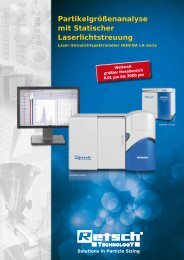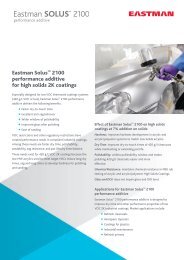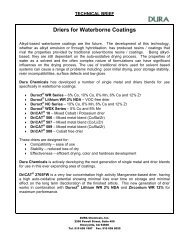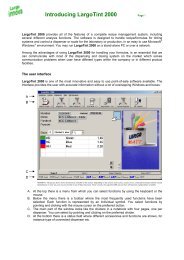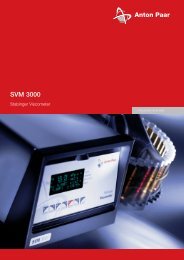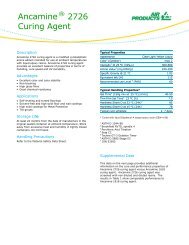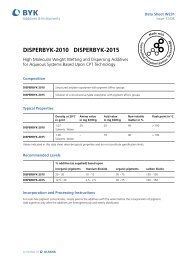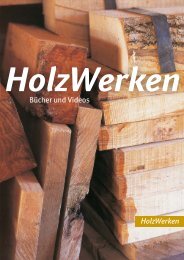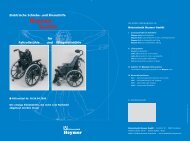Create successful ePaper yourself
Turn your PDF publications into a flip-book with our unique Google optimized e-Paper software.
HEUCODUR ® <strong>IR</strong>I N O R G A N I C P I G M E N T SHow to stay cool?Smart Complex Inorganic Colored Pigments
HEUCODUR ® <strong>IR</strong> IntroductionHow to turn Blackinto Cool?Jumping out of the box is an objective every pioneeringand forward-thinking coatings chemist or engineer likes toachieve.Mo<strong>de</strong>rn and innovative coatings are striving for an apparentbreak-through effect that imparts the coating system anobvious ad<strong>de</strong>d value. This ambition is driven by the generalneed for creating more and more cost efficient productswithout turning them into commodities.To prevail it is essential to focus on the right raw materials.One of the most innovative options is the use of “smart”materials.A smart pigmentation is a pigmentation that is capable torespond to changes in its environment or that may alsoexhibit an unexpected functionality.What does thermo controlling mean?It is well known, that a white surface remains cool, whilea black one heats up. The reason for this is the interactionof the coated object with the near infrared-radiation (N<strong>IR</strong>)emitted by the sun (figure 1).The sun emits almost 50% of its energy as <strong>IR</strong>-radiation.When this N<strong>IR</strong>-radiation is absorbed light is physicallyconverted into heat. A surface interacts not only byabsorbing radiation but also by emitting in the far infraredregion until the equilibrium at a certain temperature isreached. By using a conventional pigmentation this effectcould result in a severe build-up of heat.Black surfaces strongly absorb N<strong>IR</strong>- and visible light, whilewhite surfaces are effective in reflecting N<strong>IR</strong>- and visiblelight. But white or pastel colors cannot always satisfy theconsumer’s <strong>de</strong>mands.Differently colored pigments exhibit different, specificelectromagnetic reflection profiles as shown in figure 2.Focusing on the <strong>IR</strong>-range (780-2500 nm) a pigmentlike rutile yellow exhibits the highest reflection followedby titanium dioxi<strong>de</strong>. On the other hand carbon blackbenchmarks the lowest reflection. Compared to carbonblack a consi<strong>de</strong>rable higher reflectance in the N<strong>IR</strong>-regionof the solar spectrum can be achieved by a specifically<strong>de</strong>signed <strong>IR</strong>-reflecting spinel black pigment.
HEUCODUR ® <strong>IR</strong> PerformanceThese different and characteristic reflectance curves are alsomirrored in different heat build-up curves shown in figure 3. In theheat build-up experiment a coated panel is exposed to artificialN<strong>IR</strong>-light in a closed box un<strong>de</strong>r <strong>de</strong>fined conditions. The increase oftemperature is measured together with the duration of exposure.By reflecting the N<strong>IR</strong>-radiation more efficiently, this pigmentationgives coatings the ability to significantly reduce the surfacetemperature. This effect can be visualized by a thermo-imagingcamera as shown in figure 4.The thermo images show coated panels pigmented withdifferent <strong>IR</strong>-reflecting pigments on the left si<strong>de</strong> and with carbonblack on the right si<strong>de</strong> respectively. Afterwards the panels werehomogeneously irradiated using an <strong>IR</strong>-lamp un<strong>de</strong>r <strong>de</strong>finedconditions.The advantage we can get from this approach is not only areduction of the heat build-up that can be correlated with<strong>de</strong>creased energy consumption. The benefit is also an enhancedshelf life of the coating.Due to the significant reduction in surface temperature, thermal<strong>de</strong>gradation of the polymeric matrix is reduced. In additiontemperature differences between day and night, direct sunlightand shadowed areas etc. will also be levelled out. As aconsequence thermal warping becomes less effective.This aspect of the use of thermo controlling pigments is veryimportant, because this effect can be utilised for numerous otherapplications – not only housing, roofing and faca<strong>de</strong>s.This is the key reason, why this approach truly <strong>de</strong>serves the labelSMART. Not only because it contributes to a more environmentallyaware use of resources, but also because of its exceptional abilityto extend the shelf life of exterior coatings or polymers.Smart Complex Inorganic Colored PigmentsWe are looking for efficient <strong>IR</strong>-reflecting pigmentsoffered in different color sha<strong>de</strong>s, exhibiting anoutstanding durability to their inten<strong>de</strong>d use in exteriorcoatings and available on large scale.In or<strong>de</strong>r to select the right pigments we need to dig alittle bit <strong>de</strong>eper into theory:Comparing pigments regarding their influence on theheat build-up always <strong>de</strong>pends on the polymeric matrix.Figure 5 shows as an example the different reflectancecurves of titanium dioxi<strong>de</strong>s in different matrices. Asa consequence the characteristic absorption of solarradiation needs to be taken into consi<strong>de</strong>ration when<strong>de</strong>signing an effective <strong>IR</strong>-reflecting coating formulation.
HEUCODUR ® <strong>IR</strong> PerformanceWhat is TSR?When selecting an effective <strong>IR</strong>-reflecting pigment the most important factor is the TSR value. TSR means Total SolarReflectance and is the integral total amount of solar energy that is immediately rejected by a surface material (e.g. coating).That means that it inclu<strong>de</strong>s UV-, visible- as well as N<strong>IR</strong>-radiation and is thus a key figure to <strong>de</strong>scribe the heat build-up ofsurfaces.Due to the fact, that the TSR covers the entire range of radiation between UV and N<strong>IR</strong>, e.g. black pigments showsystematically lower TSR values compared to e.g. white pigments. Therefore only TSR values of similar pigments should becompared.A high TSR value indicates efficient reflection – a low TSR value indicates a strong ten<strong>de</strong>ncy to absorb N<strong>IR</strong>-light andtherefore induce significant heat build-up. It is helpful to interpret the TSR value in relation to the matrix used and/or areference pigment (e.g. titanium dioxi<strong>de</strong>).Furthermore it should be consi<strong>de</strong>red, that even small amounts of impurities can negatively effect the TSR of the coating.Even fillers, which are usually ad<strong>de</strong>d to the paint, can potentially reduce the resulting reflectance in the near infrared.On the other hand varying the pigment load (10% to 30%) does not generally cause notably different TSR values.An additional influence on the scattering of electromagnetic radiation is given by the particle size distribution.The scattering of electromagnetic radiation can be <strong>de</strong>scribed using Mie’s theory. The scattering of light of the wavelengthλ is <strong>de</strong>pen<strong>de</strong>nt from the diameter (D*) of a spherical particle and the difference between the refractive indices of thepigment (nP) and the matrix (nM). A first estimation on the interrelation of the refractive indices and particle size is given bythe following simple formula:As a consequence smaller particles selectively reflect short-wave radiation, while larger particles more efficiently reflectlong-wave radiation. This effect is used to control and adjust the scattering properties of pigments.Figure 7 shows two chemically i<strong>de</strong>ntical Pigment Black 30 pigments with different particle size distributions. The pigmentblack 30 with the particle size distribution shifted towards larger particles, exhibits especially in the long wavelength region,a significantly higher reflectance compared to the black 30 pigment with a smaller particle size.
HEUCODUR ® <strong>IR</strong> The Solution The SolutionTo achieve maximum reflection of solar radiation a N<strong>IR</strong>-reflectivepigmentation of exterior coatings is required, that provi<strong>de</strong>s a high TSRvalue and the highest outdoor durability. All these requirements canbe fulfilled by mixed metal oxi<strong>de</strong> pigments, which exhibit specially<strong>de</strong>signed reflectance characteristics whilst retaining their excellentweather and light fastness (s. figure 8) as well as their exceptionaltemperature resistance.Looking at the thermo images in figure 4 the effect of different TSRvalues becomes apparent:The difference in the TSR values of approximately 5% on the left paneland 17% on the right panel results in a drastically stronger heat buildupof the carbon black pigmented coil coating.These novel, <strong>IR</strong>-reflecting complex inorganic colored pigments offer awi<strong>de</strong> range of color sha<strong>de</strong>s from yellow to black.They allow the formulation of not onlyarchitectural, building and constructioncoatings, tiles, plasters etc., but alsoautomotive exterior and interior applicationslike dash-boards, fuel tanks, etc.Because of the reduced surface temperaturethe use of these pigments extends theshelf-life of the polymeric matrix through aminimization of thermo induced <strong>de</strong>gradationeffects and of course substantially reducesthe heat build-up.By that they take care for the customer’scomfort as a result of reducing the heatbuild-up and thus his electricity bill.Reference1)Used pigments: H152, H550, H5G, H910,H940 and H950 correspond withHEUCODUR ® <strong>IR</strong> 152, 550, 5G, 910, 940and 950 manufactured by HeubachGmbH.2) According to ASTM D 4803-97.
HEUCODUR ® <strong>IR</strong> ProductsName Mass Tone Tint (1:1)Pigment Color In<strong>de</strong>xNickel and Chromium Rutile PigmentsHEUCODUR ® PLUS <strong>IR</strong> Yellow 150 Nickel Antimony Titanium Yellow Rutile P.Y. 53HEUCODUR ® <strong>IR</strong> Yellow 152 Nickel Antimony Titanium Yellow Rutile P.Y. 53HEUCODUR ® <strong>IR</strong> Yellow 156 Nickel Antimony Titanium Yellow Rutile P.Y. 53HEUCODUR ® <strong>IR</strong> Yellow 3R Chrome Antimony Titanium Buff Rutile P.Br. 24HEUCODUR ® <strong>IR</strong> Yellow 256 Chrome Antimony Titanium Buff Rutile P.Br. 24HEUCODUR ® <strong>IR</strong> Yellow 259 Chrome Antimony Titanium Buff Rutile P.Br. 24(Inverse) Spinel PigmentsHEUCODUR ® <strong>IR</strong> Blue 550 Cobalt Aluminate Blue Spinel P.Bl. 28HEUCODUR ® <strong>IR</strong> Blue 2RCobalt Aluminate Blue Spinel P.Bl. 28HEUCODUR ® <strong>IR</strong> Blue 5-100Cobalt Chromite Blue Green SpinelP.Bl. 36HEUCODUR ® <strong>IR</strong> Blue 4GCobalt Chromite Blue Green SpinelP.Bl. 36HEUCODUR ® <strong>IR</strong> Blue 559Cobalt Chromite Blue Green SpinelP.Bl. 36HEUCODUR ® <strong>IR</strong> Green 5G Cobalt Titanate Green Spinel P.G. 50Browns & BlacksHEUCODUR ® <strong>IR</strong> Brown 869 Chromium Iron Oxi<strong>de</strong> P.Br. 29HEUCODUR ® <strong>IR</strong> Black 910 Hematite, Chromium Green-Black P.G. 17HEUCODUR ® <strong>IR</strong> Black 920 Iron Chromite Brown Spinel P.Br. 35HEUCODUR ® <strong>IR</strong> Black 940Iron Chromite Brown Spinel P.Br. 35HEUCODUR ® <strong>IR</strong> Black 950 Chrome Iron Nickel Black Spinel P.Bk. 30Due to the limitation of printing process, some slight variations between the color as illustrated may be observed.
HEUCODUR ® <strong>IR</strong>Technical DataTSROil Absorption Heat Resistance[%] 1) [ ml/100g ] 2) [ ˚C ] 3)64 16 80063 17 80061 16 80058 20 < 60055 17 80054 16 80034 30 8002730 < 60024 17 < 80024 15 < 80019 1480023 17< 80022 25 70021 17< 80022 20 80024 2280010 17< 8001)Alkyd-melamine, 20% pigmentation 2) according to DIN EN ISO 787/5 3) AA10/CIC/104
www.heubachcolor.<strong>de</strong>® = Registered tra<strong>de</strong>mark of Heubach GmbHOur product specific and application information are based upon our current knowledge. They are non-binding and cannot be taken as a guarantee. The processing companymust establish the suitability of individual products itself. As their use lies beyond our knowledge and control, we cannot accept any liability relating to the use of our products inparticular applications. In addition to that, the legal rights of third parties must always be consi<strong>de</strong>red. The specification agreed between the customer and ourselves is the basisupon which our general sales and <strong>de</strong>livery conditions are set and is the <strong>de</strong>ciding factor concerning any liabilities. Our standard specification is then valid if no specification hasbeen agreed upon between the customer and ourselves.Europe: Heubach GmbH · Heubachstraße 7 · 38685 Langelsheim · Germany · Tel 49-5326-52-0 · Fax 49-5326-52-213USA: Heucotech Ltd. · 99 Newbold Road · Fairless Hills, PA 19030 · USA · Tel 1-800-HEUBACH · Fax 1-215-736-2249Asia: Heubach Colour Pvt. Ltd. · 2nd Floor, Landmark-Building · Race Course Circle · Baroda 390 007 – India · Tel 91-265-2343-310 · Fax 91-265-2341-682E-Mail: sales@heubachcolor.<strong>de</strong> 04/2008



